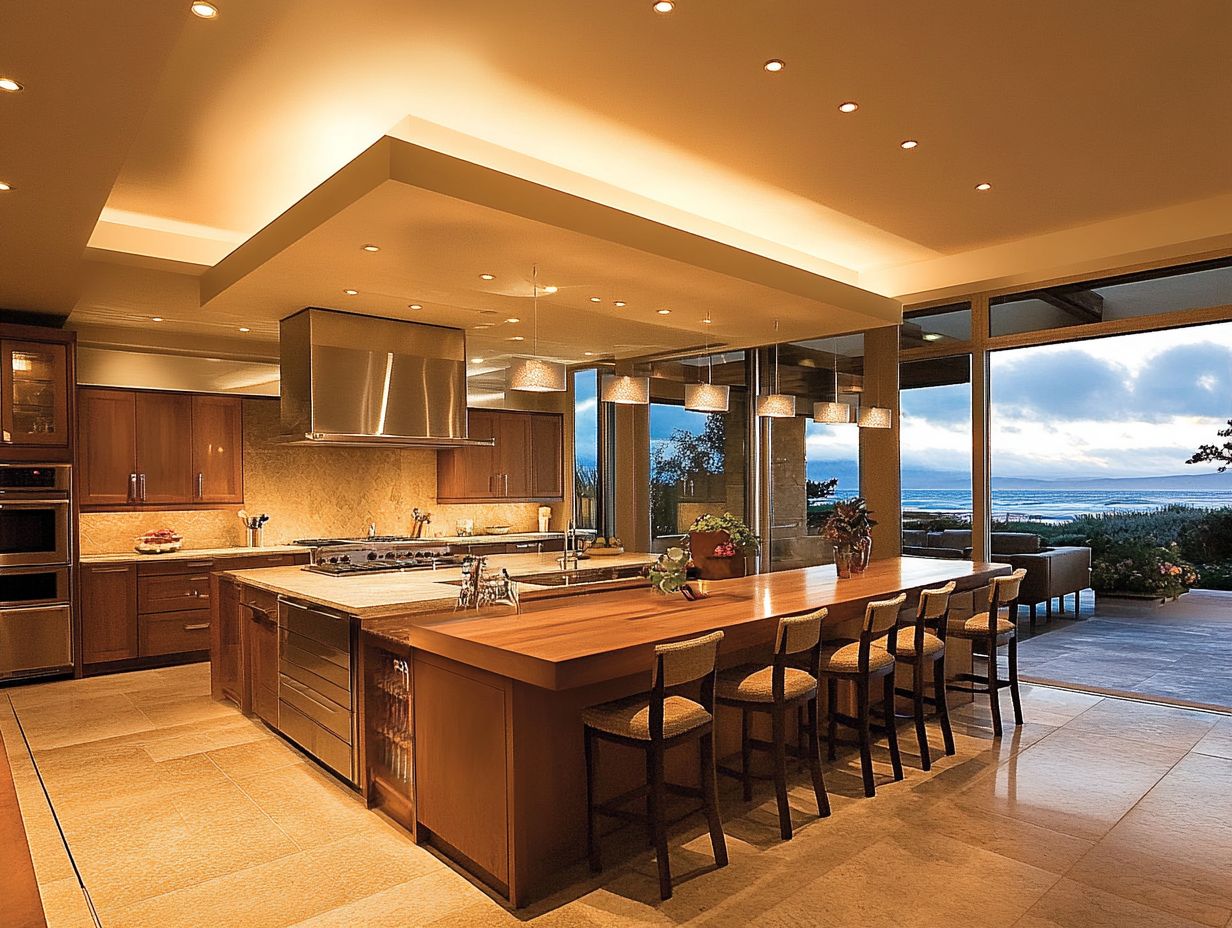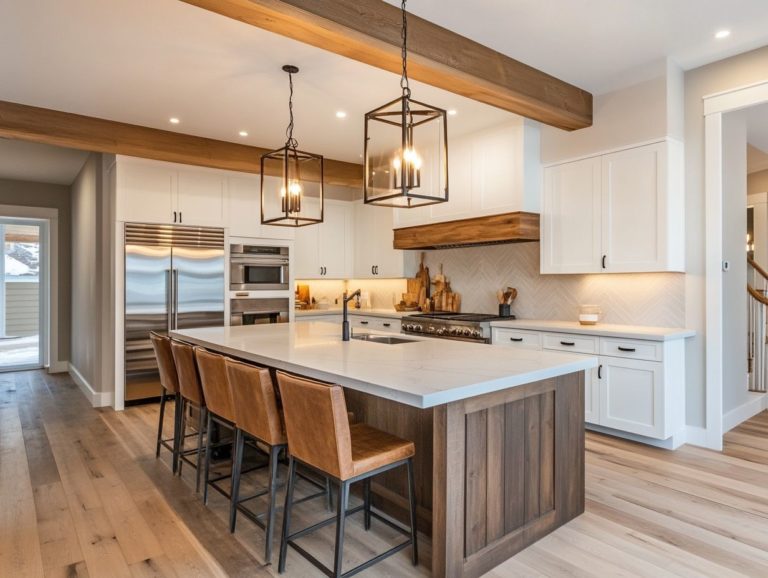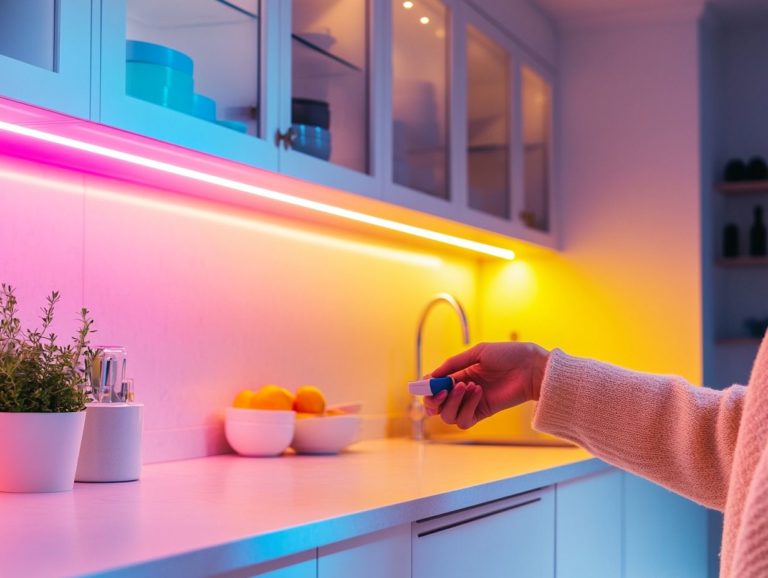5 Tips for Proper Kitchen Lighting Placement
Get ready to transform your kitchen into a brilliantly lit sanctuary! Follow these five key tips to illuminate every corner beautifully.
Creating the ideal ambiance in your kitchen transcends merely selecting fashionable fixtures; it hinges on the artful placement of lighting.
Here are five important tips to elevate your kitchen’s layout for optimal illumination, ensuring every nook radiates brilliance.
- Begin by evaluating your current setup; grasp the significance of task lighting, which helps you see clearly while you cook or work, and energy efficiency, and uncover the latest trends along with common pitfalls to steer clear of.
Prepare to transform your kitchen into a brilliantly lit sanctuary!
Contents
- Key Takeaways:
- 1. Assess Your Kitchen Layout
- 2. Consider the Functionality of Each Area
- 3. Choose the Right Type of Lighting
- 4. Create Layers of Light
- 5. Don’t Forget About Task Lighting
- What Are the Benefits of Proper Kitchen Lighting?
- How Can Proper Lighting Enhance the Look of Your Kitchen?
- What Are the Common Mistakes to Avoid When Placing Kitchen Lighting?
- How Can You Incorporate Energy-Efficient Lighting in Your Kitchen?
- What Are the Latest Trends in Kitchen Lighting Placement?
- How Can You Personalize Your Kitchen Lighting Placement?
- Frequently Asked Questions
- What is the importance of proper kitchen lighting placement?
- What are the top 5 tips for proper kitchen lighting placement?
- How can I utilize natural light in my kitchen?
- What are some examples of task lighting in the kitchen?
- How can I create a well-layered lighting design in my kitchen?
- What are some common mistakes to avoid when placing kitchen lighting?
Key Takeaways:

Act now! Assess your kitchen layout before choosing your lighting. Use various lighting types to create an inviting atmosphere and save on energy costs with efficient options.
1. Assess Your Kitchen Layout
Assessing your kitchen layout is the crucial first step in crafting a modern kitchen that harmoniously combines functionality and aesthetic allure. You want to ensure that every corner of the space serves a purpose while fostering family interactions and gatherings.
As you evaluate the layout, consider how traffic flow influences movement throughout the area. Smooth transitions between cooking, dining, and socializing are essential for a pleasant experience.
The placement of appliances is vital. An efficient arrangement can enhance your daily tasks. Don’t overlook the importance of lighting.
By incorporating a mix of task, ambient, and accent lights, you not only elevate the visual appeal but also enhance practicality, ensuring each section of your kitchen is well-lit.
Ultimately, a thoughtfully designed layout is the backbone of a kitchen that not only functions beautifully but also showcases your personal style.
2. Consider the Functionality of Each Area
Understanding how each area of your kitchen functions—from the cooking space to the dining area—gives you the power to select the right fixtures and lighting that enhance both usability and comfort. This thoughtful approach creates a harmonious environment perfect for family gatherings.
Each zone within the kitchen, such as countertops, islands, and dining areas, has its unique lighting requirements. For example, task-oriented spaces like preparation areas thrive on bright, focused lighting, ensuring safety and precision while you cook.
On the other hand, atmospheric lighting in dining spaces cultivates a warm, inviting ambiance, encouraging leisurely meals and meaningful conversations. Selecting the right style of fixtures not only boosts functionality but also complements the kitchen’s overall aesthetic.
By illuminating each area effectively, you can transform an ordinary kitchen into a beautifully integrated space that satisfies both practical needs and visual appeal.
3. Choose the Right Type of Lighting
Choosing the right type of lighting is crucial for crafting a kitchen that strikes the perfect balance between task, ambient, and accent lighting. Each fixture should enhance both the atmosphere and functionality of your space.
By thoughtfully incorporating these lighting types, you can ensure safety during food preparation while also creating a warm and inviting ambiance. Task lighting should be strategically placed over work areas like countertops and islands, while ambient lighting provides an overall glow that makes the room feel larger and more welcoming.
Accent lighting can then highlight design features such as decorative backsplashes or artwork, injecting personality into your kitchen.
When selecting lighting, consider opting for energy-efficient LED options. Not only do they reduce energy consumption, but they can also significantly lower your electricity bills. Pairing these fixtures with decorative designs that reflect your kitchen’s style will create a cohesive look, making the space both functional and aesthetically pleasing.
Start your kitchen transformation today with these essential tips!
4. Create Layers of Light

Creating layers of light in your kitchen brightens the space. It also adds visual interest and depth. It gives you the power to control the atmosphere and mood, making the area feel cozy for family gatherings or vibrant for entertaining guests.
You can create a balanced and functional environment by combining general, task, and accent lighting.
-
General lighting serves as the foundation, ensuring that every corner of your kitchen is bathed in bright illumination.
-
Task lighting, on the other hand, lights up your work areas like countertops or islands, making meal prep both easier and safer.
-
Accent lighting infuses character, drawing attention to artwork or architectural features that deserve the spotlight.
For added versatility, consider installing dimmers and adjustable fixtures. This allows you to seamlessly transition between bright, lively settings and soft, intimate ones, customizing the light levels to perfectly match any occasion.
5. Don’t Forget About Task Lighting
Task lighting plays a vital role in your kitchen design, especially in workspaces like the kitchen island and cooking area. Specialized fixtures such as recessed lighting and under-cabinet lights light up your work areas while enhancing safety and minimizing shadows.
The right illumination is crucial for activities like chopping vegetables, reading recipes, or sautéing ingredients; dim or uneven lighting can lead to unfortunate mishaps. To achieve optimal lighting, consider placing adjustable pendant fixtures above your kitchen island for flexible light placement.
Strategically installed LED strips beneath your cabinets can provide focused light directly onto your countertops. Transform your space with strategically placed LED strips! They’ll provide not just light, but a new vibe.
This thoughtful approach enhances visibility for greater accuracy and elevates the kitchen’s overall aesthetic, transforming it into a more enjoyable and efficient space for your culinary adventures.
What Are the Benefits of Proper Kitchen Lighting?
Proper kitchen lighting offers a multitude of benefits, enhancing safety, improving functionality, and creating an inviting atmosphere that balances coziness with energy. This change makes your kitchen a fun and welcoming space for everyone.
By illuminating every corner and surface, adequate lighting effectively reduces shadows that may obscure potential hazards, ensuring that spills and clutter remain visible. This proactive design approach not only prevents accidents but also elevates the overall environment.
With today’s array of lighting options, you can craft a warm ambiance that encourages conversations and family gatherings. When executed thoughtfully, energy-efficient lighting solutions can also lead to lower utility bills, demonstrating that a beautiful kitchen can be both sustainable and practical.
This harmonious blend of beauty and functionality results in a space that feels safe, inviting, and efficient.
How Can Proper Lighting Enhance the Look of Your Kitchen?
Proper lighting can truly transform your kitchen, highlighting décor elements, adding depth, and creating focal points with strategically placed fixtures that draw attention to artwork or architectural features.
Picture a minimalist kitchen where sleek pendant lights gracefully hang above an island, crafting a stunning centerpiece that beautifully contrasts with clean lines and a neutral palette.
Now, imagine the charm of a rustic-themed space, where warm, dimmable sconces accentuate wooden beams and cabinetry, all while evoking a cozy ambiance.
For those who lean toward a more eclectic style, mixing vintage chandeliers with modern recessed lighting can create a playful yet sophisticated vibe.
These intentional placements not only illuminate vital work areas but also elevate the kitchen’s overall aesthetic, transforming it into a warm and inviting hub for gathering and culinary creativity.
What Are the Common Mistakes to Avoid When Placing Kitchen Lighting?

Avoiding common mistakes in kitchen lighting placement is essential for achieving a well-lit kitchen. Neglecting brightness levels or creating unwanted shadows can hinder both functionality and design.
Many homeowners overlook the importance of adequate task lighting, which often leads to frustration when preparing meals. Relying solely on overhead fixtures can leave countertops dimly lit, impacting your productivity.
Choosing inappropriate fixtures can deprive your space of necessary light quality and brightness. It’s vital to incorporate a harmonious blend of general, work, and decorative lighting.
Installing under-cabinet lights can illuminate your work surfaces perfectly. Adjustable pendant lights over islands provide functionality and style, ensuring balanced illumination for all your culinary endeavors.
How Can You Incorporate Energy-Efficient Lighting in Your Kitchen?
Incorporating energy-efficient lighting, especially with LED options, slashes energy consumption and boosts the longevity of your fixtures. This ensures optimal brightness and temperature control.
Switching to LED can significantly reduce your electricity bills, offering financial relief while fostering a more eco-friendly home. When selecting LED lights, pay close attention to both color temperature and brightness.
Warm white tones create a cozy atmosphere for family gatherings, while cooler temperatures invigorate the space during cooking sessions.
Exploring dimmable options can elevate the ambiance, allowing your kitchen to shift seamlessly from bright task lighting for meal prep to softer tones for evening get-togethers. The right fixtures contribute to both comfort and efficiency.
What Are the Latest Trends in Kitchen Lighting Placement?
The latest trends in kitchen lighting highlight a modern aesthetic that skillfully blends creative fixtures with strategic layering of light. This ensures functionality and style coexist harmoniously in your kitchen design.
These trends maximize kitchen efficiency while showcasing your personal style. Innovative fixture designs, such as pendant lights and under-cabinet illumination, provide ambient lighting and accentuate key work areas.
Carefully placing dimmers and task lighting significantly enhances kitchen functionality, making it adaptable for cooking and entertaining.
As you seek to personalize your environment, integrating unique designs that reflect your tastes becomes essential. This transforms your kitchen into a vibrant hub of creativity and activity.
How Can You Personalize Your Kitchen Lighting Placement?
Personalizing your kitchen lighting placement showcases your unique style while addressing your family’s practical needs. Every light source should harmonize with the overall design, creating a cohesive atmosphere.
Consider how various lighting options can elevate both ambiance and functionality. Customizing fixtures to align with your aesthetic allows for a delightful fusion of form and function—whether you prefer sleek modern designs or vintage charm.
Selecting colors that complement your cabinetry and wall finishes unifies the look, drawing the eye and creating inviting focal points. Imagine the warm glow of pendant lights above your dining area or under-cabinet lighting highlighting your favorite dishware—each choice enhances your space’s distinctive vibe.
Frequently Asked Questions

What is the importance of proper kitchen lighting placement?
Proper kitchen lighting placement is crucial for creating a functional and visually appealing space. It improves visibility, enhances overall design, and creates a comfortable environment for cooking and dining.
What are the top 5 tips for proper kitchen lighting placement?
Here are the top 5 tips for kitchen lighting:
- Start with a general light source.
- Layer your lighting.
- Use task lighting for work areas.
- Add decorative lighting for ambiance.
- Maximize natural light.
How can I utilize natural light in my kitchen?
Natural light brightens your kitchen and cuts energy costs. Install large windows, skylights, or glass doors to let the sunshine in.
Light-colored paint and reflective surfaces can help bounce light around the room too!
What are some examples of task lighting in the kitchen?
Task lighting is crucial for work areas like countertops, sinks, and stoves. Use under-cabinet lights, recessed lights, or pendant lights to provide focused light where you need it most.
How can I create a well-layered lighting design in my kitchen?
Layered lighting includes three types: general, task, and decorative. Combine overhead lights, task lights, and decorative accents to create a functional and appealing design.
What are some common mistakes to avoid when placing kitchen lighting?
Avoid common pitfalls like ignoring how the space is used or failing to use various light types. Also, be cautious with the number of lights you install to prevent a harsh atmosphere.





